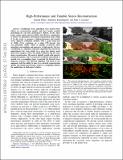High-performance and tunable stereo reconstruction
Author(s)
Ramalingam, Srikumar; Pillai, Sudeep; Leonard, John J
DownloadLeonard_High-performance.pdf (3.220Mb)
OPEN_ACCESS_POLICY
Open Access Policy
Creative Commons Attribution-Noncommercial-Share Alike
Terms of use
Metadata
Show full item recordAbstract
Traditional stereo algorithms have focused their efforts on reconstruction quality and have largely avoided prioritizing for run time performance. Robots, on the other hand, require quick maneuverability and effective computation to observe its immediate environment and perform tasks within it. In this work, we propose a high-performance and tunable stereo disparity estimation method, with a peak frame-rate of 120Hz (VGA resolution, on a single CPU-thread), that can potentially enable robots to quickly reconstruct their immediate surroundings and maneuver at high-speeds. Our key contribution is a disparity estimation algorithm that iteratively approximates the scene depth via a piece-wise planar mesh from stereo imagery, with a fast depth validation step for semi-dense reconstruction. The mesh is initially seeded with sparsely matched keypoints, and is recursively tessellated and refined as needed (via a resampling stage), to provide the desired stereo disparity accuracy. The inherent simplicity and speed of our approach, with the ability to tune it to a desired reconstruction quality and runtime performance makes it a compelling solution for applications in high-speed vehicles.
Date issued
2016-06Department
Massachusetts Institute of Technology. Computer Science and Artificial Intelligence Laboratory; Massachusetts Institute of Technology. Department of Electrical Engineering and Computer Science; Massachusetts Institute of Technology. Department of Mechanical EngineeringJournal
Proceedings of the 2016 IEEE International Conference on Robotics and Automation (ICRA)
Publisher
Institute of Electrical and Electronics Engineers (IEEE)
Citation
Pillai, Sudeep, Srikumar Ramalingam, and John J. Leonard. “High-Performance and Tunable Stereo Reconstruction.” IEEE, 2016. 3188–3195.
Version: Original manuscript
ISBN
978-1-4673-8026-3